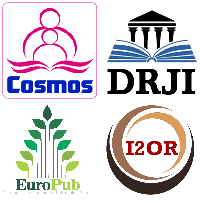The Effects of Salinity Conducted on the Main Potato Varieties: Shangi, Tigoni, Chulu, Dutch Robjin, Lenana, and Nyota in vitro in Kenya
Abstract
Salinity stress is a major environmental factor limiting potato (Solanum tuberosum) productivity in Kenya. In this study, we investigate the response of primary in vitro potato varieties to saline conditions, aiming to identify salt-tolerant varieties and explore the underlying physiological mechanisms for arid and semi-arid areas. In vitro, subcultures of different potato varieties were exposed to varying concentrations of sodium chloride (NaCl), 0mm, 10mm, 60mm, and 100mm, simulating saline stress conditions in the Murashige and Skoog (MS) media. Growth parameters, including in vitro height (IH), number of roots (NR) and their density (RD), number of internodes and their length, and number of leaves, were monitored over a set period of 30 days. Results indicated significant varietal differences in response to salinity, with some varieties demonstrating enhanced salt tolerance through better maintenance of cellular integrity and osmotic adjustment. Most varieties proved to be adversely affected by the high levels of NaCl, i.e., 60mm and 100mm. The findings of this study provide valuable insights into the salt tolerance mechanisms of potatoes and highlight the potential of in vitro screening as a tool for breeding salt-resistant cultivars for arid and semi-arid regions under irrigation. These results contribute to developing sustainable potato cultivation practices in saline-affected soils.
References
CIP. (2019). Potatoes for Prosperity. Nairobi.
Jha, G., Choudhary, O. P., & Sharda, R. (2017). Comparative effects of saline water on yield and quality of potato under drip and furrow irrigation. Cogent Food & Agriculture, 3(1), 1369345.
Maathuis, F. J. (2014). Sodium in plants: perception, signalling, and regulation of sodium fluxes. Journal of Experimental Botany, 65(3), 849-858.
Naziri, D., Devaux, A., Hareau, G., & Wauters, P. (2024). Supply and demand of processed potato products in Kenya, Rwanda, and Uganda: variety requirements of processing companies and implications for trait prioritization for breeding. Potato Research, 1-25.
Ng’ang’a, J. (2023). State to introduce potato farming in ASAL regions through irrigation. Nairobi: Kenya News Agency.
NPCKKENYA. (2023, February 1). Retrieved from npck kenya potato growing counties: https://npck.org/potato-growing-counties-in-kenya/
Nyang'au, M. N., Akutse, K. S., Fathiya, K., Charimbu, M. K., & Haukeland, S. (2023). Biodiversity and efficacy of fungal isolates associated with Kenyan populations of potato cyst nematode (Globodera spp.). Biological Control, 186, 105328.
Rahman, M. H., Islam, R., Hossain, M., & Haider, S. A. (2009). Differential response of potato under sodium chloride stress conditions in vitrio. Journal of Bio-Science, 16, 79-83.
Shrivastava, P., & Kumar, R. (2014). Soil salinity: A serious environmental issue and plant growth promoting bacteria as one of the tools for its alleviation. Saudi Journal of Biological Sciences, 22(2), 123-131.
Wafula, V. (2021, May 26). Yara Kenya. Retrieved from YARA EAST AFRICA: https://www.yara.co.ke/crop-nutrition/agronomy-advice/soil-salinity/
Copyright (c) 2025 Kiambi, M.M., Seneni, M.N., Cherotich, P., Odhiambo, G.O

This work is licensed under a Creative Commons Attribution 4.0 International License.


 ISSN
ISSN 











